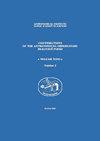在太阳附近的大熊座W型双星的人口
IF 0.2
4区 物理与天体物理
Q4 ASTRONOMY & ASTROPHYSICS
Contributions of the Astronomical Observatory Skalnate Pleso
Pub Date : 2020-03-01
DOI:10.31577/caosp.2020.50.2.495
引用次数: 0
摘要
大熊座W型双星属于我们银河系的老星系,而它们的金属丰度接近太阳。它们的物理性质、运动学和空间分布反映了它们的恒星祖先的性质。本研究的重点是在我们的太阳附近500pc半径内的wuma的空间分布,结合天体测量,光度和光谱测定它们的恒星参数。样品是经过精心挑选的,以满足某些标准,并具有明确的金属丰度和距离参数。H-R图以及类似的相关图(质量半径和质量光度)表明,这些系统中的主要成分(质量更大)位于ZAMS区域附近或以下,而次要成分似乎是进化的,因为它们具有共同的包络几何形状。为了判断银河系某些位置的环境特性和演化,对一些突出的异常值进行了仔细的检查。结果发现,金属丰度与距离无关,但金属丰度[M/H]与演化状态之间存在弱相关性,其表现为体系在H- r图中的位置、双星类型(a或W)和温度。本文章由计算机程序翻译,如有差异,请以英文原文为准。
The population of W Ursae Majoris-type binaries in the solar neighborhood
W Ursae Majoris-type binaries belong to the old population of our Galaxy, while their metallicity is close to solar. Their physical properties, kinematics and spatial distribution reflect the properties of their stellar progenitors. This study focuses on the spatial distribution of W UMa’s in our solar neighborhood within a 500 pc radius, with a combined astrometric, photometric and spectroscopic determination of their stellar parameters. The sample is carefully selected, in order to fulfill certain criteria, and has well defined metallicity and distance parameters. H-R diagram, as well as similar correlation plots (mass-radius and mass-luminosity), show that the primary (more massive) components in such systems are located close or below the ZAMS region, while secondary components seem to be evolved, as a result of their common envelope geometry. Some prominent outliers are carefully examined in order to judge the environmental properties and evolution in certain locations of the Milky Way. It is found that metallicity is not correlated with distance, but there is a weak correlation between metallicity [M/H] and evolution state, as it is expressed by the location of the systems in the H-R diagram, the type of binary (A or W), and temperature.
求助全文
通过发布文献求助,成功后即可免费获取论文全文。
去求助
来源期刊
CiteScore
1.10
自引率
20.00%
发文量
4
审稿时长
>12 weeks
期刊介绍:
Contributions of the Astronomical Observatory Skalnate Pleso" (CAOSP) is published by the Astronomical Institute of the Slovak Academy of Sciences (SAS). The journal publishes new results of astronomical and astrophysical research, preferentially covering the fields of Interplanetary Matter, Stellar Astrophysics and Solar Physics. We publish regular papers, expert comments and review contributions.

 求助内容:
求助内容: 应助结果提醒方式:
应助结果提醒方式:


